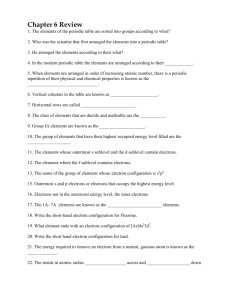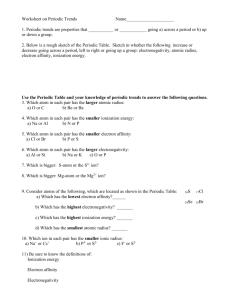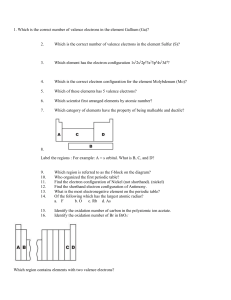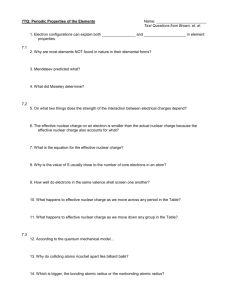Key
advertisement
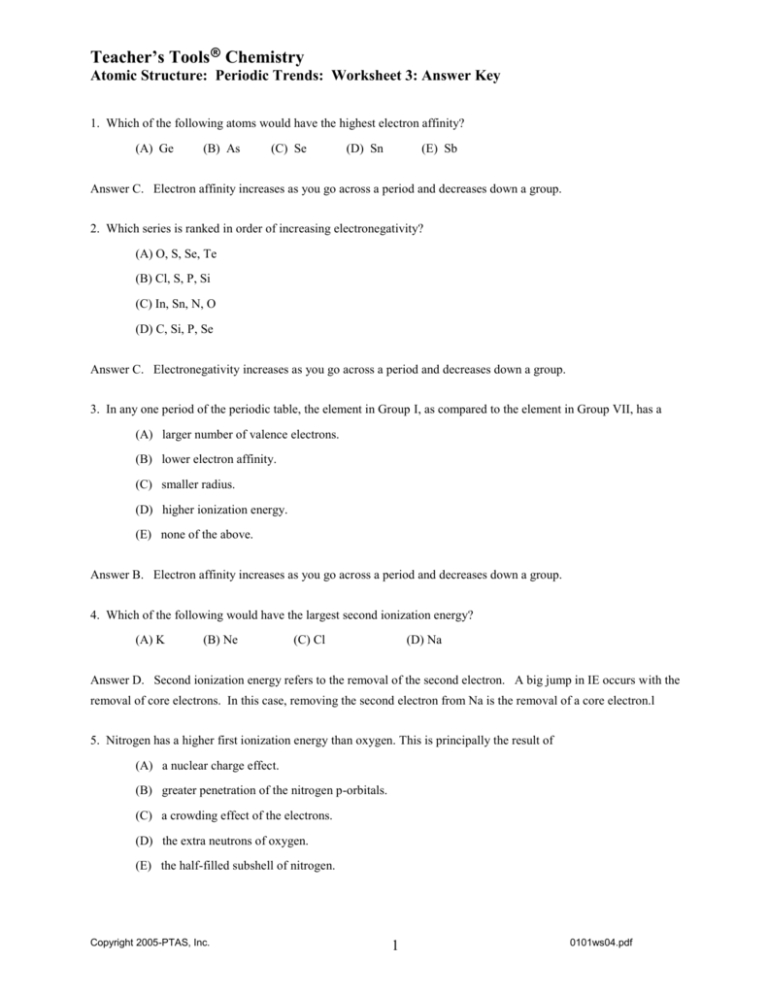
Teacher’s Tools® Chemistry Atomic Structure: Periodic Trends: Worksheet 3: Answer Key 1. Which of the following atoms would have the highest electron affinity? (A) Ge (B) As (C) Se (D) Sn (E) Sb Answer C. Electron affinity increases as you go across a period and decreases down a group. 2. Which series is ranked in order of increasing electronegativity? (A) O, S, Se, Te (B) Cl, S, P, Si (C) In, Sn, N, O (D) C, Si, P, Se Answer C. Electronegativity increases as you go across a period and decreases down a group. 3. In any one period of the periodic table, the element in Group I, as compared to the element in Group VII, has a (A) larger number of valence electrons. (B) lower electron affinity. (C) smaller radius. (D) higher ionization energy. (E) none of the above. Answer B. Electron affinity increases as you go across a period and decreases down a group. 4. Which of the following would have the largest second ionization energy? (A) K (B) Ne (C) Cl (D) Na Answer D. Second ionization energy refers to the removal of the second electron. A big jump in IE occurs with the removal of core electrons. In this case, removing the second electron from Na is the removal of a core electron.l 5. Nitrogen has a higher first ionization energy than oxygen. This is principally the result of (A) a nuclear charge effect. (B) greater penetration of the nitrogen p-orbitals. (C) a crowding effect of the electrons. (D) the extra neutrons of oxygen. (E) the half-filled subshell of nitrogen. Copyright 2005-PTAS, Inc. 1 0101ws04.pdf Teacher’s Tools® Chemistry Atomic Structure: Periodic Trends: Worksheet 3: Answer Key Answer E. The simple explanation is the stability of a half-filled sublevel. 6. Which of the following ions is largest in size? (A) O2- (B) Al3+ (C) Na+ (D) F- (E) Mg2+ Answer A. For atoms, atomic radius decreases across a period and increases down a row. In terms of ions, cations are smaller than their associated atoms (the contract with the loss of electrons) and anions are larger than their associated atoms (they expand to accommodate the repulsion of additional electrons.) Oxygen gained the largest number of electrons. 7. Which of the following is least metallic? (A) I (B) O (C) Cs (D) K (E) Te Answer B. Metallic character increases diagonally as you move from the upper right corner to the lower left corner of the periodic table. Also, in this case, a non-metal was one of the choices. 8. The elements in which of the following have most nearly the same atomic radius? (A) Be, B, C, N (B) Ne, Ar, Kr, Xe (C) Mg, Ca, Sr, Ba (D) C, P, Se, I (E) Cr, Mn, Fe, Co Answer E. Atomic radius decreases across a row and increases down a group. This is primarily due to the increase in effective nuclear charge and the shielding affect. Atomic d orbitals are not as penetrating as s or p orbitals and therefore do not shield as much. The atomic radii of the transition metals therefore vary much less than the first two and last 6 groups. 9. In the periodic chart, where would you look for the most electronegative elements? (A) upper left side (B) lower left side (C) upper right side (D) lower right side (E) the bottom period Answer C. Electronegativity increases as you go across a period and decreases down a group. The most electronegative Copyright 2005-PTAS, Inc. 2 0101ws04.pdf Teacher’s Tools® Chemistry Atomic Structure: Periodic Trends: Worksheet 3: Answer Key elements are in the upper right side of the periodic table. 10. Atoms generally become smaller with increasing atomic number within a period because (A) of additional electron repulsion. (B) of increased effective nuclear charge. (C) smaller electrons are used later in a period. (D) the nucleus absorbs some of the electrons. (E) of the additional neutrons required for nuclear stability. Answer B. Atomic radius decreases across a row and increases down a group. This is primarily due to the increase in effective nuclear charge and the shielding affect. 111. Which of the following elements would have the smallest first ionization energy? (A) Mg (B) F (C) O (D) Ca (E) Si Answer D. The smallest first ionization energy is associated with the atom that will most easily lose its outermost electron. Oxygen, fluorine and silicon are on the wrong side of the periodic table. Both Mg and Ca have two valence electrons but Ca is larger. Both have very similar effective nuclear charges but because of the 1/r2 force dependence for electrostatic attraction, Ca will exert less of a force on its outer electrons than Mg. 12. Which of the following electronic configurations would represent an atom with the smallest electron affinity (smallest negative energy)? (A) ns2np1 (B) ns2np2 (C) ns2 (D) ns2np4 (E) ns2np5 Answer C. A simple way of stating this is which of these configurations least wants to gain an electron. The completely full s-sublevel least wants to gain another electron. 13. Assume that an element has the following ionization energies: 1st IE = 600 kJ/mol 2nd IE = 1,800 kJ/mol 3rd IE = 2,750 kJ/mol 4th IE = 11,600 kJ/mol 5th IE = 15,000 kJ/mol Copyright 2005-PTAS, Inc. 3 0101ws04.pdf Teacher’s Tools® Chemistry Atomic Structure: Periodic Trends: Worksheet 3: Answer Key Which of the following is the most probable electron configuration for this element? (A) 1s22s22p6 (B) 1s22s22p63s2 (C) 1s22s22p63s1 (D) 1s22s22p63s23p1 (E) 1s22s22p63s23p3 Answer D. Look for the big jump in IE indicative of the removal of a core electron. Here it occurs between the third and fourth ionization energies. That means the fourth electron is a core electron and the atom had 3 valence electrons. Copyright 2005-PTAS, Inc. 4 0101ws04.pdf


